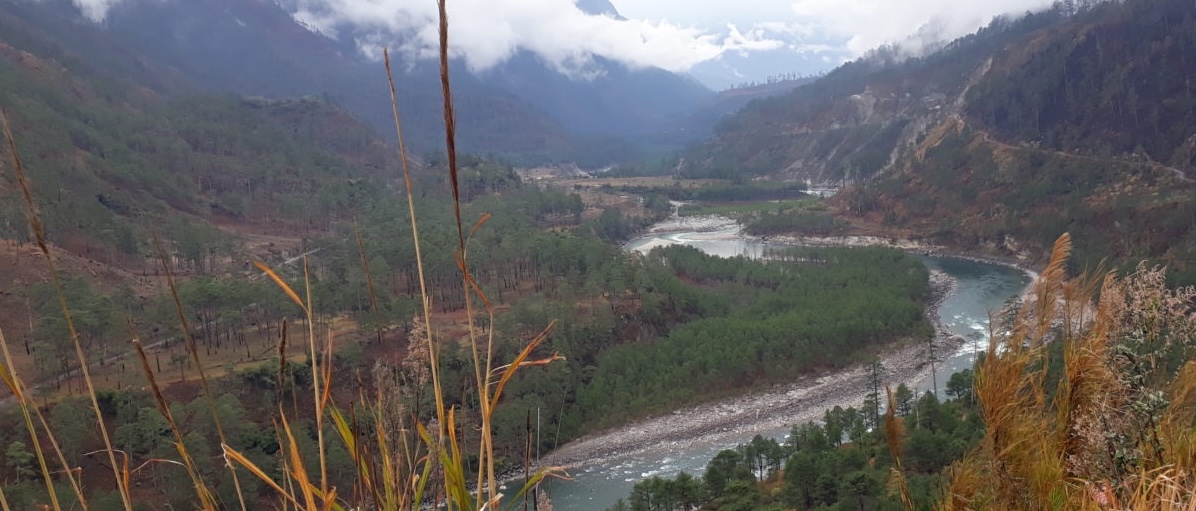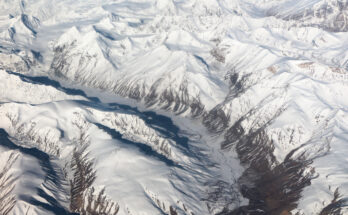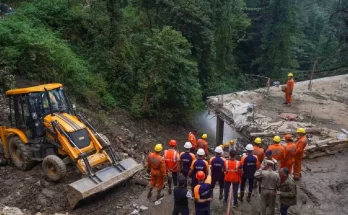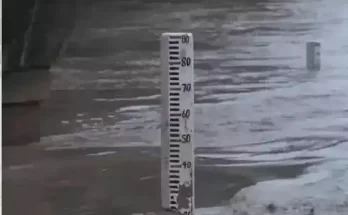Two-thirds of the Hindu Kush Himalaya glaciers are projected to vanish by the end of the century.

The Himalayan Range (Photo credit: Twitter/@UTDBofficial)
New Delhi, May 29: Since Mount Everest was conquered, 79 glaciers surrounding it have thinned by more than 100 metres. On the 70th anniversary of the ascent of the world’s tallest mountain on Monday, mountain communities, glaciologists, and mountaineers have called for urgent action to counter the impact of climate change on the higher reaches of the Himalayas.
Sir Edmund Hillary and Sherpa Tenzing Norgay made history by stepping on Mt Everest on May 29, 1953. After Hillary’s demise in 2008, May 29 is celebrated as International Mount Everest Day. With global warming concerns, the celebration is tinged with worry.
A November 2020 study noted the deterioration of glaciers around Everest in six decades and found that the thinning rate has nearly doubled since 2009. Among the 79 affected glaciers is the iconic Khumbu, which is the starting place for most expeditions to Everest.
“Greater glacier mass loss will also affect the much relied-upon seasonality of both local and regional river flow as well as limit the longevity of Himalayan glaciers as a sustainable component of the Asian water tower. Within the Khumbu Valley, glacial melt provides ∼65% of the water used by the local community during the pre-monsoon dry season. Continued glacier melt and snowpack decline will clearly increase water stress within the Mt Everest region before the initiation of the monsoon each year,” the study published in the journal One Earth stated.
The International Centre for Integrated Mountain Development (ICIMOD) flagged that the “climate emergency is here for the Earth’s tallest mountain, 70 years on from the first ascent with two-thirds of the Hindu Kush Himalaya glaciers projected to vanish by the end of the century.”
Dr Anil Kulkarni, glaciologist and Distinguished Visiting Scientist, Divecha Centre for Climate Change, Indian Institute of Science (IISc), Bengaluru, said, “A rise of 1 degree Celsius on the plains means a 1.5-degree rise in the Himalayas. But for Mt Everest which is over 8,000 metres, this can mean a 2.0 degree Celsius rise. As you go higher, the temperature increases more and that is causing the glaciers at higher altitudes to melt.”
Everest is part of the Hindu Kush Himalaya (HKH) region, which extends 3,500 km across eight countries: Afghanistan, Pakistan, India, Nepal, Bhutan, Bangladesh, China (Tibet), and Myanmar. The dangerous impacts of global warming are already being felt throughout the Hindu Kush Himalaya in record-breaking heatwaves, droughts, natural disasters, unpredictable snowfall, and precipitous and largely irreversible glacial melt.
“We need urgent global action to protect the lives and livelihoods of the two billion people in this region and to safeguard the countless, irreplaceable lifeforms that exist only here,” said Pema Gyamtsho, Director General, ICIMOD.
Nearly a quarter of the world’s population depends on the water that flows from the rivers – including Indus, Ganga, Brahmaputra, and Irrawaddy – originating in the Himalayas.
Impact on Indian Himalayas
The adverse impact of climate change is not limited to just the Everest region. Glaciers in six Indian states and Union Territories spread over 2,500 km of the Himalayas are also facing similar conditions.
“Downstream, there is a substantial use of water from both glacier melt and snow melt. Hydropower is one predominant use. The melting period of the seasonal snow has already changed and glaciers are shrinking. So, the water quantum from such glaciers is changed and it has affected the profitability of hydropower,” Kulkarni said.
The rapid melting of seasonal snow has other serious impacts, too. “The soil moisture has significantly reduced when it happens and that has led to early forest fire season in the Himalayas. The reduced soil moisture also impacts the water in the mountain springs – the source of water for mountain communities – and there is a complete change in the mountain ecology,” the glaciologist added.
Darjeeling-based Roshan P Rai of the Integrated Mountain Initiative (IMI), which works to mainstream the concerns of the Indian Himalayan Region and mountain communities, pointed out a stark indicator of changing climate in the Indian side of the Himalayas. “The flowers are blooming way ahead of their time as winters are not as harsh and sprint/summer is early. Not just temperature but our precipitation pattern,too, has changed. But the most powerful indicator can be that we now have mosquitoes here in the hills,” he said.
“We can see Mt Kanchenjunga from Darjeeling and I have seen the change in my own lifetime. We see more rock face now, snow is missing,” Rai stated, adding that the efforts of the government “do not reflect the urgency of the crisis that we are in.”
#SaveOurSnow campaign
“We – mountain communities, climbers, and scientists – stand at the top of the world today, 70 years after humanity’s first ascent of Everest, to call for governments and business leaders and every man, woman, and child across the world to come together to protect Earth’s mountains, snow, and ice,” said a petition launched two days ago and signed by 1,500 people, including two sons of Norgay, one of Hillary’s sons and a granddaughter, and Prime Minister of New Zealand Helen Clark, along with scores of Everest climbers and researchers.
The declaration calls on governments to honour their commitments under the Paris Agreement, make rapid and deep emission cuts, end all new coal, oil, and gas exploration, besides accelerating the transition to renewable energy.
Tenzing Chogyal Sherpa, ICIMOD glaciologist and grandson of Kanchha Sherpa, the last remaining survivor of the first expedition to Mt Everest, said, “Those of us who study, live or climb in the mountains are eyewitnesses to the terrifying speed of changes happening in our cryosphere – often caused by actions taken millions of miles away. We are calling on everyone that loves these fragile places to raise their voice about the impacts of continued inaction on emissions reductions and to call for world leaders and businesses to speed up the transition to renewables to save our snow.”
Since the first attempts to scale Mt Everest started about 100 years ago, more than 6,000 people have climbed it, many of them multiple times. The mountaineering community, adventure community, and the ICIMOD are using the anniversary to rally the need for greater action to save the Himalayas and the glaciers.
(This story first appeared on news9live.com on May 29, 2023 and can be read here.)



